Key Takeaways
- Ireland’s emerald fields have roots in ancient farming traditions and a temperate climate.
- Atlantic blues link to Ireland’s long coastline, where sea trade and fishing shaped history.
- Heather purples emerge from native moorland flowers, hinting at Gaelic stories and lore.
- Historical records and local crafts reveal how these hues shaped cultural identity.
- Visitors often explore these colors through coastal walks, rural drives, and heritage sites.
Introduction

Ireland’s colorful charm has stirred imaginations for centuries. Rolling hills of rich green, deep ocean blues, and the soft purples of heather seem to greet wanderers at every turn. Many folks wonder how these vibrant hues rose to fame and why they matter. Are they mere symbols on postcards, or do they hold deeper meaning? Are they part of the country’s past or something that has grown over time?
This article digs into the heart of Ireland’s striking palette. It highlights each tone, looks at historical records, and uncovers how these shades mesh with Irish identity. It doesn’t rely on color psychology. Instead, it focuses on specifics: farmland practices, Gaelic legends, and centuries of sea trade. Plus, it shows how travelers can experience these colors in real ways, through crafts, scenic routes, and local traditions.
The sections below split the topic into digestible chunks. Each one includes three subsections for more detail. Readers can jump around or follow the entire narrative from start to end. There’s also a handy summary table before the final FAQ. Everything aims to paint a comprehensive scene of Ireland’s bold palette.
The Rise of Ireland’s Emerald Green
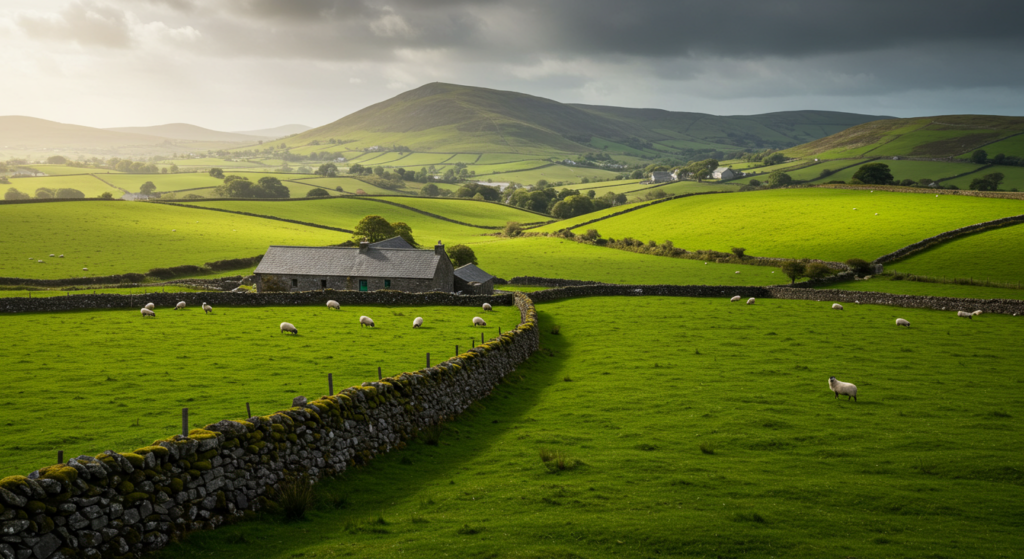
Gaelic Roots and Early Agriculture
How did Ireland earn the nickname “Emerald Isle”? Early clans in ancient times cultivated small fields and meadows, using methods passed down through family lines. The climate was mild, with frequent rain. Crops thrived, and grass remained a constant green. This lush farmland could be seen in every region, from Munster to Ulster. Over time, visitors remarked on the vibrant fields and rolling hills. Historians suggest that poems and stories from the Gaelic language often praised these vast green lands. That praise likely sparked the image of Ireland as a land draped in emerald shades.
The Gaelic people nurtured a sense of place tied to the green fields. Their daily life revolved around seasonal growth and communal harvests. This meant the color green became a sign of life. Old Gaelic terms hinted at how farmland anchored the clan’s well-being. Even clans with simple tools could manage rich yields. Generations cherished that success, and the emerald tone came to symbolize luck and vitality in local lore.
Role in National Symbols
Ireland’s flag includes a green section that stands for older Gaelic traditions and Catholic communities. When Irish groups sought independence in the 19th and early 20th centuries, green banners waved at gatherings. People wore green badges or ribbons during protests against external powers. Some traced this color to the shamrock, a plant that grew in fields across the island.
Green also showed up in more subtle ways, like official uniforms or book covers for cultural associations. The color tied to ideals of self-rule, heritage, and unity. Over time, the world saw Ireland’s green flag as a sign of hope for a free land. This notion persists in modern times, though the political backdrop has changed. Green remains a staple in national celebrations, from music festivals to public ceremonies.
Folklore and Poetry
Storytellers often describe Ireland’s hills in glowing terms. Ancient ballads mention “the green sod of home,” while bardic poets conjure images of fairies dancing in meadows. These tales give the color a magical edge. People listened to yarns of hidden spirits who lived under mossy ground, or at the foot of a towering oak. The green fields served as a stage for these mythic events.
Poetic works from the 18th and 19th centuries praised the emerald landscape. Writers pointed to the “soft, unending green” that rolled out to the horizon. Some hinted at how the land’s hue matched the depth of Irish resilience through times of famine and conflict. Although modern readers may view these lines as romantic, the descriptions reflect how folks felt about the ever-present green of their homeland.
Atlantic Blues: Oceanic Heritage
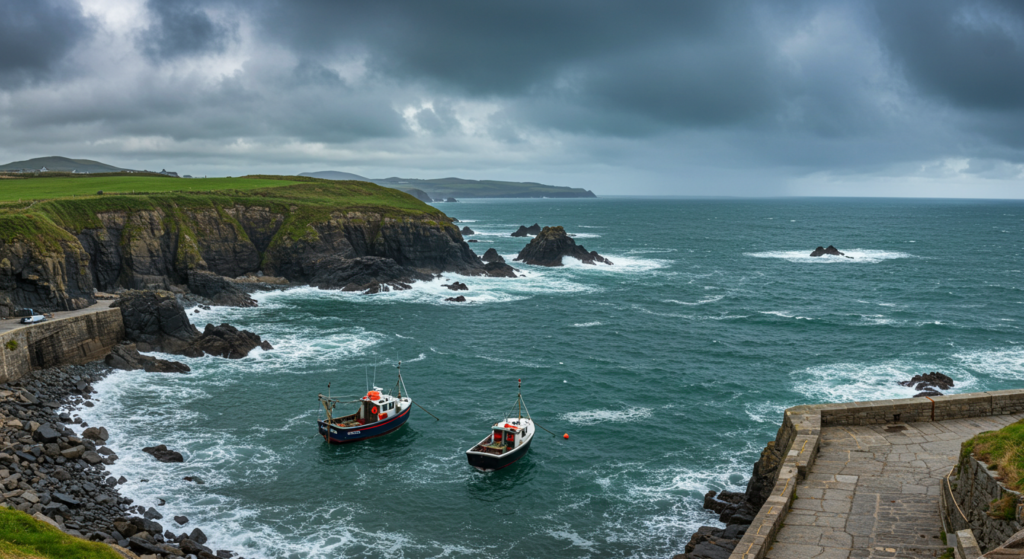
Maritime Trade and Coastal Towns
Why do so many travelers speak about the stunning blues along Ireland’s coastline? The island’s position in the Atlantic gave rise to ports and seafaring communities. Centuries ago, small wooden boats set sail, packed with goods and dreams of trade. Fishermen cast nets in the early morning, hoping for bountiful catches. Busy docks in Cork or Galway bustled with local wares, foreign imports, and the constant hum of boat traffic.
That maritime trade shaped Ireland’s link to the deep ocean blues. Local folks saw the Atlantic as both a giver and a taker. Storms could claim lives, yet calm seas offered wealth. The color blue became an emblem of oceanic fortune, reflecting waves that carried commerce and culture. Coastal towns thrived on this exchange, turning the blue horizon into a path for trade routes. This interplay with the sea fostered a robust seafaring identity.
Naval Conflicts and Shifts in Power
In certain periods, Ireland’s waters witnessed naval clashes. Empires viewed the Irish coast as a key vantage point. Naval fleets might anchor off the shore, seeking safe harbors or strategic advantage. The color blue, once seen as a trade route, turned into a stage for conflict. Ships flying various flags battled for control of these prized waters.
Local historians note that these maritime struggles shaped Ireland’s alliances and identity. Coastal communities served as watchers, sounding the alarm if invading ships approached. The local pride in the Atlantic deepened, with towns rallying behind their harbors and beaches. The color blue took on a new shade of defense, an echo of watchtowers on rocky cliffs. Over time, with calmer seas and shifting borders, these same waters welcomed peacetime trade again.
Artistic Depictions of the Coast
Painters, scribes, and craftspeople have long tried to capture the soul of Ireland’s coast. Older watercolor paintings show rolling waves tinted with dark and light blues. Harbor scenes might highlight rugged fishermen, stout wooden boats, and shimmering water. Irish poetry sometimes references the “ever-faithful tide,” leaning on the concept of water as a life force.
Even carved stone crosses in seaside areas display wave patterns. Those swirling lines stand as tributes to nature’s power. Modern muralists in towns like Dingle or Kinsale feature sweeping Atlantic panoramas on shop fronts. Tourists often pause to photograph these massive artworks. Each piece underscores the ongoing bond between Ireland’s communities and the ocean’s sapphire and teal hues.
Heather Purples Across the Moorlands

Heather’s Botanical Origins
Heather is a low-growing plant found in windswept places, particularly peat bogs and upland slopes. Its blooms show a soft purple that shifts in tone depending on the season. Botanists note that the plant belongs to the Ericaceae family. It thrives in acidic soil, which abounds in many Irish moorlands. The climate fosters growth in wide patches. Visitors often see entire hillsides blanketed in this gentle purple color.
Heather is sometimes used in old remedies. Though not as famous as other herbs, it has a history in folk medicine. Locals might have used dried heather stems for bedding or weaving. The color alone catches the eye, but the plant’s resilience on harsh moors adds to its appeal. It grows in places where few other flowers can survive. The presence of heather sets a peaceful atmosphere in Ireland’s higher altitudes.
Gaelic Legends and Spiritual Ties
Certain Gaelic legends mention purple blooms that hint at enchantment. Scholars and local storytellers say the color was linked to calm or hidden paths. Gaelic songs might describe a wanderer crossing purple hills, seeking answers from ancestral spirits. While these tales aren’t always documented in official records, they persist in local lore.
Folklore also suggests that patches of heather were meeting spots for neighbors to gather. Old ceremonies might have taken place among these purple clusters, with minimal props, yet a strong sense of community. Though official details are scarce, references in ballads mention the hue as a symbol of closeness to nature. Modern visitors walking these heather-rich trails sometimes remark on a hush that settles in, as if the moorland invites reflection.
Use in Traditional Crafts
Heather’s wood and stems provide materials for weaving small baskets or decorative wreaths. Some craftspeople still gather it in late summer, when blossoms are at their peak. They bind it into neat bundles, letting the purple tips show. It’s not as famous as other rural crafts, yet it holds a special place in niche artisan work.
Historic accounts mention how farmers would dry heather to create thatch or bedding. In places, dried heather might line the ceiling or walls, adding earthy insulation. Even certain dyes can be made from the plant’s leaves, although the resulting color leans toward light brown or gray rather than bright purple. This subtle presence in crafts underscores heather’s quiet role in everyday rural life.
Historical Ties to Irish Monasteries
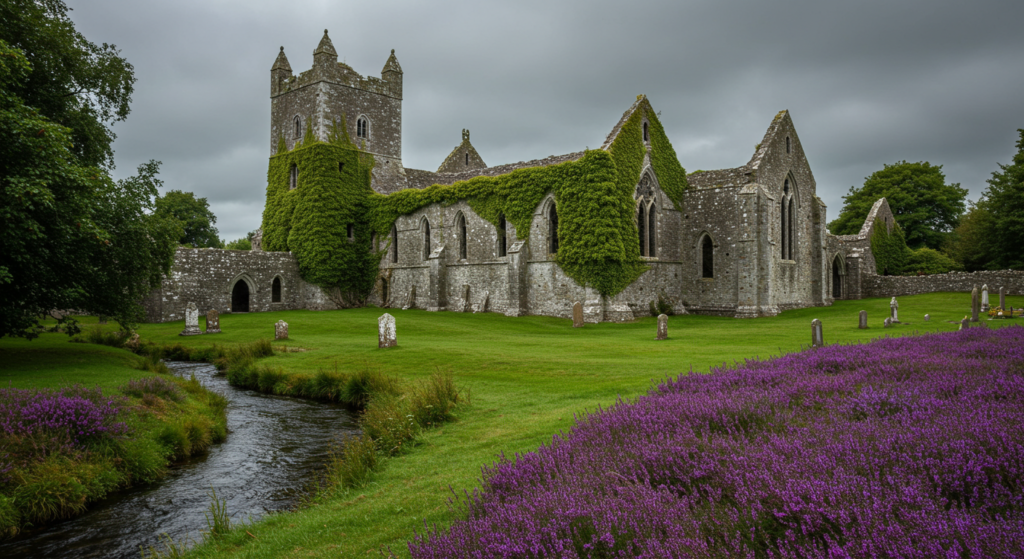
Early Christian Influence
Why do medieval monasteries come up when discussing Ireland’s color story? Monastic scribes preserved documents that described the land’s green fields, stormy seas, and remote moors. These records included early references to the emerald hue. Prayer books or illustrated manuscripts, like the Book of Kells, often showcased vivid colors. Some scholars point to the graceful detailing in Celtic art, with spirals or knots that used pigments from natural sources.
During these centuries, monks lived in isolation, often close to moorland or near rocky shores. They had time to observe nature’s subtle shifts. Their writings reflect a deep appreciation for Ireland’s changing palette. Through these texts, the idea of a green island and a powerful ocean gained a sacred tone. That sense of reverence persisted in local culture long after the monastic golden age ended.
Preservation of Herbal Knowledge
Monks also gathered plants for healing. Heather, with its gentle purple blooms, was listed in certain herbal notes. While not the star of these records, it appeared in tonics or potions intended for mild ailments. This practice strengthened the connection between spiritual life and the land. The color purple, tied to the moorland heather, found its way into monastic contexts.
Monasteries served as hubs of learning, so that knowledge spread across Ireland. People traveled to these religious centers to gain wisdom. While color references were not their main focus, the quiet presence of local flora left an imprint. Bits of that tradition still linger, with modern herbal enthusiasts tracing older formulas back to monastic texts.
Architectural Legacy
Many monasteries stand in ruins now, but visitors still see tall stone walls and arches. In some cases, moss and small plants creep over the stone, adding soft green tints to the gray. This interplay highlights Ireland’s bond with vegetation. Sea air might nibble away at the mortar, leaving salt deposits that appear white or bluish. Heather can grow in nearby fields, adding flickers of purple to the scene.
Photographers often capture these historic sites under dramatic skies. The ocean might be visible in the distance, or farmland might stretch nearby. The visual clash of ancient architecture with nature’s palette reveals how these monasteries once thrived at the core of Irish life. It’s a timeless reminder that color in Ireland is more than a tourist cliche. It’s a testament to centuries of faith, labor, and resilience.
Impact of Viking and Norman Invasions

Shifts in Farming Practices
When Viking raiders arrived, they seized coastal areas and navigated inland. Some settlers stayed, merging with local communities. This influenced farming techniques and crop choices. Certain fields shifted to new grains or livestock. Yet the land’s green presence remained, thanks to Ireland’s steady rainfall and mild temperatures. The color green stayed strong, even under outside rule.
Farmers adapted to changes in land ownership, learning fresh strategies from foreign settlers. Some took on new livestock that thrived in Ireland’s damp climate. Vikings favored coastal living, drawn by trade opportunities. Over time, farmland near big ports might feed foreign ships, but it still looked lush from a distance. The emerald tone, so linked to identity, continued as a quiet constant.
Coastal Fortifications
Normans built strongholds near the water, erecting thick stone castles. These fortresses often overlooked blue Atlantic waters. The color contrast between gray stone walls and the ocean’s hues gave these sites a dramatic feel. As families or clans pledged loyalty to Norman lords, local fishing or trade routes changed hands. The Atlantic blues became the setting for power shifts.
Under Norman rule, new ports emerged. Harbors became hubs for goods, from salt to fish and produce. The sea’s color took on a practical role in daily life, fueling shipping and commerce. People learned to rely on the Atlantic for trade while dealing with new taxes or laws. Though times were tense, the deep blue horizon still promised a link to broader markets.
Integration of Northern Influences
After these invasions, cultural blending followed. Norse patterns appeared in local crafts, including shipbuilding or metalwork. Norman traditions influenced stone carvings and forms of architecture. Green farmland was partitioned, sometimes changing ownership. Yet the sense of pride in Ireland’s natural palette lived on.
This integration yielded new styles of clothing and art. Cloth dyed with native plants might incorporate designs borrowed from Viking or Norman motifs. Traders sold these goods at markets, bridging local and foreign tastes. This gave the green, blue, and purple tones a broader appeal. Over generations, the sharp line between invader and native softened, but the land’s colors remained a common thread.
Colors in Irish Castles and Manors

Interior Design Influences
Many think of stone walls when they imagine medieval Irish castles. Inside, tapestries, rugs, and drapes offered color. Wealthy families liked patterns that reflected local nature or imported trends. Shades of green and blue could appear in woven hangings. Some designs highlighted scenes of hunts in the deep forest. Others showed knights on gallant quests, with the ocean as a backdrop. Regal purples, often derived from expensive dyes, might drape in the grand hall.
For manors of the 18th and 19th centuries, paint choices followed shifting fashions. Wealthy owners might choose pale green for walls or deep blue for parlors. These picks echoed the outdoors or signaled status. Purple, while less common, hinted at luxury. Some preferred subtle lilac tones in private rooms. Surviving examples of wallpaper or upholstery show how local color preferences blended with broader European styles.
Gardens and Estates
Elaborate gardens often surrounded these homes. Flowerbeds brimming with vegetation built upon the “emerald” theme of Ireland’s fields. Sometimes, owners added imported plants in bright colors. However, local blooms like heather gave these estates a unique Irish feel. The moorland aesthetic, with its hint of purple, was often included in wilder sections. Pathways might wind through large lawns, lined with hedges and shrubs that stayed green year-round.
Huge oak or yew trees provided shady spots. Man-made ponds reflected the sky, creating pockets of blue. When the sun rose at dawn, the estate glistened with moisture from overnight mists. These curated landscapes turned nature’s colors into formal statements of wealth and taste. Visitors today can explore estate grounds, noting how planned greenery merges with wild growth.
Reflections of Power and Prestige
Castles were symbols of power. The families who built them could afford fine dyes and imported goods. Rich, jewel-like colors adorned fabrics and furniture. Green might appear on a noble’s crest. Deep blue cloth could drape a throne-like chair, and purple was sometimes reserved for special garments or bedchambers. This signaled wealth in an era when certain dyes cost a fortune.
Irish clans also displayed color in their heraldry. Shields and banners carried green or blue fields, often with gold emblems. Some references mention purple as a sign of status, though green and blue were more common. Over centuries, these color codes shifted to match new political tides. Yet the island’s natural palette still shone, from farmland around the castle walls to the wide sea beyond.
Colonial Period Influences on Irish Color Identity
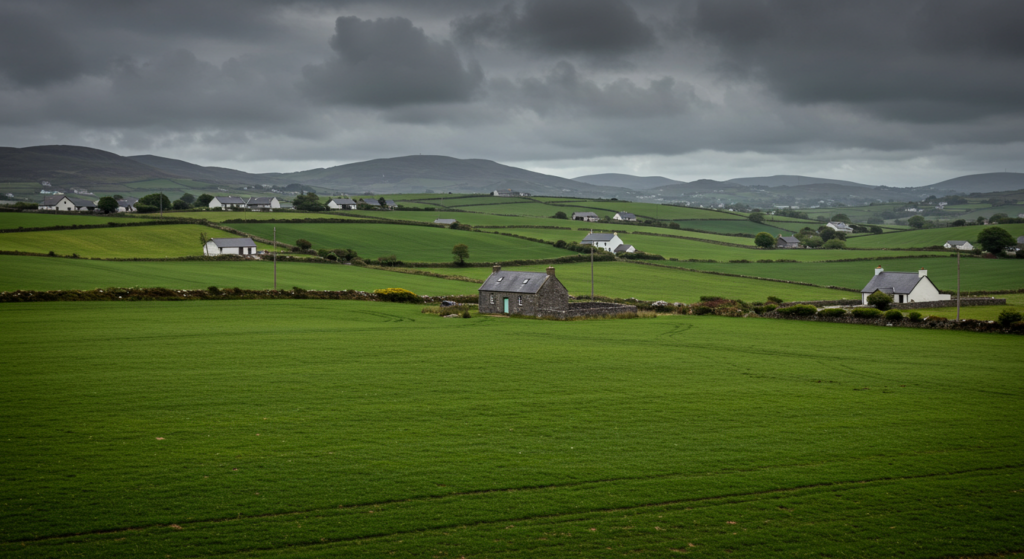
British Rule and Cultural Pressures
During centuries of British rule, local arts were often overshadowed. Some Irish traditions, including the use of Gaelic, faced restrictions. Still, the land’s color never faded. Farmers continued their routines, ensuring the countryside’s emerald hue. Writers who leaned on English to share Ireland’s story pointed out the contrast between the green island and the political climate of the time.
Green gained renewed importance as a symbol of Irish pride. Some nationalists wore green ribbons as quiet defiance. Others wrote ballads highlighting the green fields, longing for a free nation. The ocean blues remained crucial for trade and travel, though British fleets controlled many ports. Heather purples, while subtle, whispered of hidden moors and the old Gaelic spirit.
Land Tenure Changes
Colonial authorities introduced new property laws. Tenant farmers paid rent to landlords, who might have lived overseas. Despite these changes, the rolling fields stayed green. People endured harsh conditions, but the natural cycles of the land persisted. The color green acted as a lifeline for families who depended on farmland. It also served as a sign of hope during trying times.
When reforms emerged, allowing some tenant farmers to purchase plots, folks celebrated. Fields that had always been theirs in spirit became theirs in law. Over time, more families regained control of their ancestral land. That sense of ownership deepened the cultural bond to Ireland’s lush green hills. The color became a personal point of pride.
Preservation of Local Craft
Under British rule, some local crafts saw decline, yet others adapted. Traditional weaving and dyeing found new avenues, as crafters sold to outside markets. These textiles sometimes showcased moorland purples and sea-inspired blues. Local dyes, though not as flashy as synthetic ones, allowed crafters to keep old methods alive.
People passed these skills through families. While factory-made cloth became widespread, pockets of artisans stuck to older ways. For them, each hue tied back to the land. They ground plants into pigments or used seaweeds. Some crafters quietly pushed back against foreign goods, offering items that mirrored the country’s own color palette.
Ireland’s Colors in Modern Literature
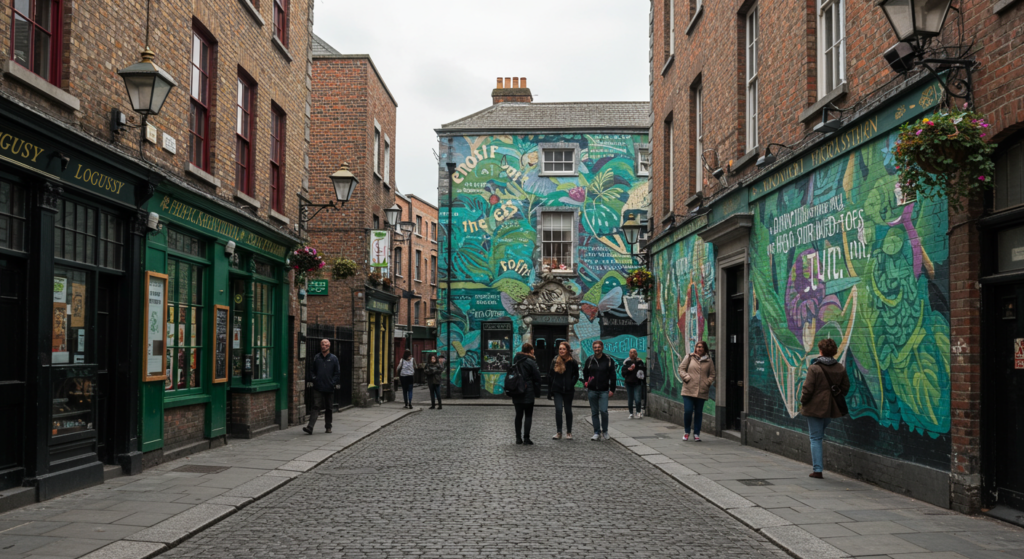
Literary Nationalism
Twentieth-century writers often used color to highlight Ireland’s identity. Some novels took place in rainy towns with green pastures in the background. Others featured dramatic scenes at sea, describing the Atlantic’s powerful blue waves. Purple moorland might appear in chapters focused on rural life, adding a touch of stark beauty. Authors found ways to paint these colors in the mind’s eye without drifting into cliches.
This approach to color helped shape literary nationalism. Characters might speak of “that green farmland behind the old stone walls,” linking it to stories of hope or heritage. The shade of the water might mirror a character’s mood, or reflect a shift in fortunes. Purple moors could hint at mystery or quiet reflection. Through fiction and poetry, these hues wove into the national tapestry.
Global Recognition
Ireland’s iconic color palette caught the attention of foreign readers. Tourists from other parts of the globe arrived, expecting to see the legendary green fields and dramatic coast. They found that reality often matched the tales. This boosted Ireland’s literary reputation, as visitors recognized the vivid descriptions were rooted in truth.
Publishers abroad marketed Irish stories with covers showing lush hills, stormy seas, or moorland scenes. This helped brand Ireland as a land of natural drama. Films and TV adaptations did the same, often opening with sweeping shots of green fields set against moody skies. Though some considered it romanticized, the influence on Ireland’s tourism and reputation was undeniable.
Modern Authors and Themes
Contemporary Irish authors continue to explore these colors, but in nuanced ways. Some highlight the tension between modern city life and rural traditions. Others place bright murals in urban scenes, giving new meaning to older shades. The green farmland may be threatened by development, the Atlantic waters might be the site of new industries, and the heather moors could be an escape from busy towns.
In many works, color remains a unifying element. It links past and present, rural and urban. Whether it’s a short story set in a small fishing village or a long novel about life in Dublin, green, blue, and purple remain quiet signatures of the island. That consistency bridges centuries of storytelling.
Tourism and Travel: Experiencing the Colors Firsthand
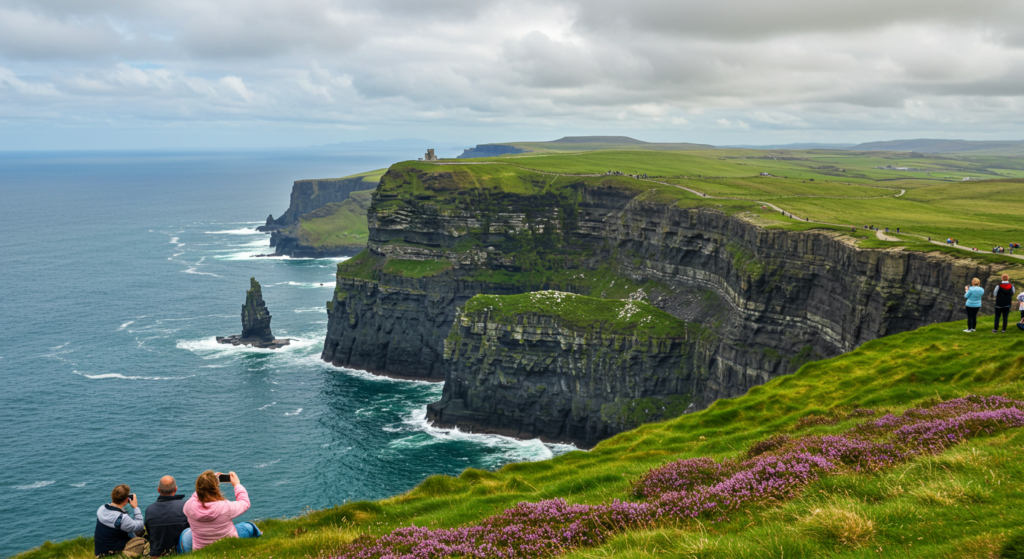
Coastal Drives and Wild Atlantic Way
Many travelers rent cars and drive along the Wild Atlantic Way. This route stretches along Ireland’s western edge. It offers endless vistas of azure seas and craggy cliffs. On clear days, the Atlantic’s blue glimmers in the sunlight. On stormy afternoons, dark waves crash against rock ledges, stirring a deep navy hue.
Stops along the route let visitors step onto beaches, taste salt air, and witness the ocean’s might. Small fishing villages provide a peek at local life, often with painted boats and nets drying on the dock. Those seeking real immersion can join boat tours or ferries to offshore isles. The color blue shifts with each passing hour, reminding travelers that Ireland’s seas are always in motion.
Walking the Green Countryside
Even short walks across Irish farmland can reveal endless shades of green. Grassy meadows, peat bogs, and thick hedgerows line winding paths. Sheep speckle the hillsides, their wool bright against the emerald backdrop. The mild climate ensures that grass stays vibrant for most of the year. Hikers might pass old stone walls, centuries old, that once marked property lines.
Guided walks lead folks through scenic valleys, with glacial lakes or hidden waterfalls. Local guides point out wild plants or mention bits of history. Some routes climb onto rocky plateaus, offering wide angles of farmland below. For travelers who crave an even quieter experience, smaller villages provide footpaths that loop around fields. Each footstep brings the bright color underfoot, tying a simple stroll to Ireland’s age-old story of land and labor.
Moorland Treks and Heather Blooms
Some prefer venturing into Ireland’s higher ground. Moorland areas, like parts of the Wicklow Mountains or the Connemara region, display heather in late summer. The sight is soft but striking. Purple sweeps across ridges where few trees grow. Stepping onto these trails can feel otherworldly, with mist drifting over hilltops. Wind often whips across the open moors, carrying a faint earthy smell.
People who trek these spots often discover ruined cottages, built from stone that blends into the wild. The heather adds a layer of color in an otherwise stark expanse. While these areas might lack the busy cheer of farmland, they hold a quiet magic. Each purple patch stands as a reminder of Ireland’s enduring spirit. Some hiking guides suggest traveling in August or September for the best view of the blossoms.
Local Food and Culinary Insights
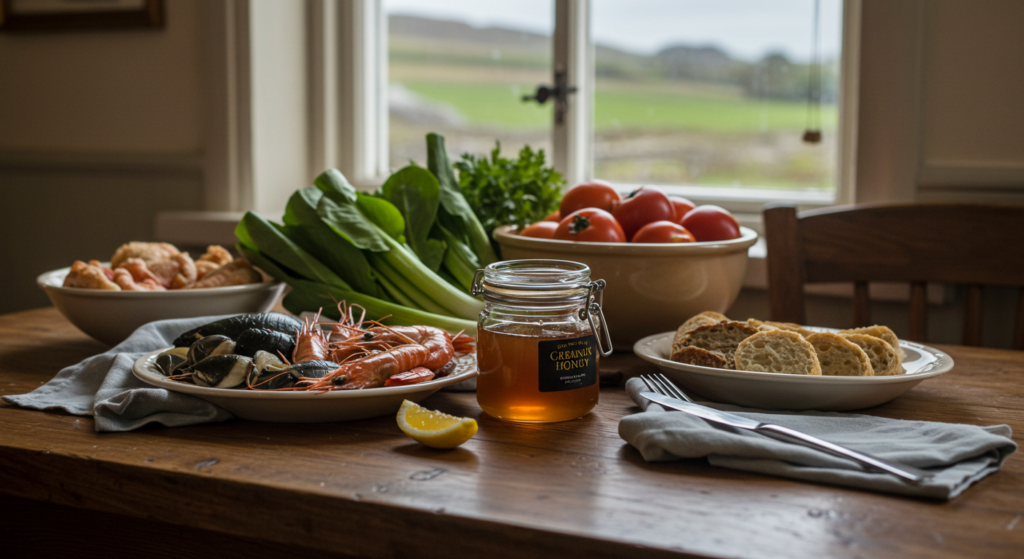
Greens on the Plate
Irish cuisine has changed over time, but fresh greens have remained a staple. Spinach, cabbage, kale, and other leafy vegetables grow well in the temperate climate. Family farms or modern organic producers share produce with local markets. Eating these greens echoes the farmland that defines Ireland’s countryside.
Dishes like colcannon blend mashed potatoes with cabbage or kale. Soups and stews often include a mix of root vegetables and leafy greens. Chefs might top salads with goat cheese or smoked salmon, leaning on local resources. Diners see that same emerald hue on their plates, in a more literal sense. Though basic, these meals speak to a relationship with the land, unchanged by time.
Seafood from Atlantic Waters
Coastal towns provide an abundance of fresh fish and shellfish. Prawns, mussels, and cod appear on menus. The Atlantic’s swirling blues nurture varied marine life, giving Irish seafood a reputation for quality. Tourists often sample fish chowder, a comforting dish on chilly days. Local fishmongers and small bistros highlight daily catches, ensuring the fish is as fresh as can be.
In some villages, families still operate small fishing boats. A crisp morning out at sea can yield a haul of mackerel or crab. That direct tie between sea and plate underscores the role of Atlantic blues in daily life. The coastline may appear tranquil from a distance, but it’s a bustling zone of marine harvest. This synergy between ocean waters and local tables keeps the color blue present, even in culinary culture.
Heather Honey and Craft Beverages
For a sweet taste of purple moorlands, some producers harvest heather honey. Bees gather nectar from the blooming heather and create honey with a rich flavor. It carries hints of floral depth, setting it apart from standard honey. This product can be found in specialty stores or local markets. People use it to sweeten tea, drizzle over scones, or glaze meats.
Craft distillers have also explored using local plants, including heather, in certain spirits. Small-batch gins might include herbs from the moors. While the flavor of heather is subtle, it adds a unique twist. Some breweries experiment with wild botanical infusions. These products offer visitors a taste of Ireland’s moorlands in liquid form. Though the hue doesn’t turn purple, the link to those blossoms adds a storytelling element for connoisseurs.
Seasonal Shifts in Ireland’s Palette
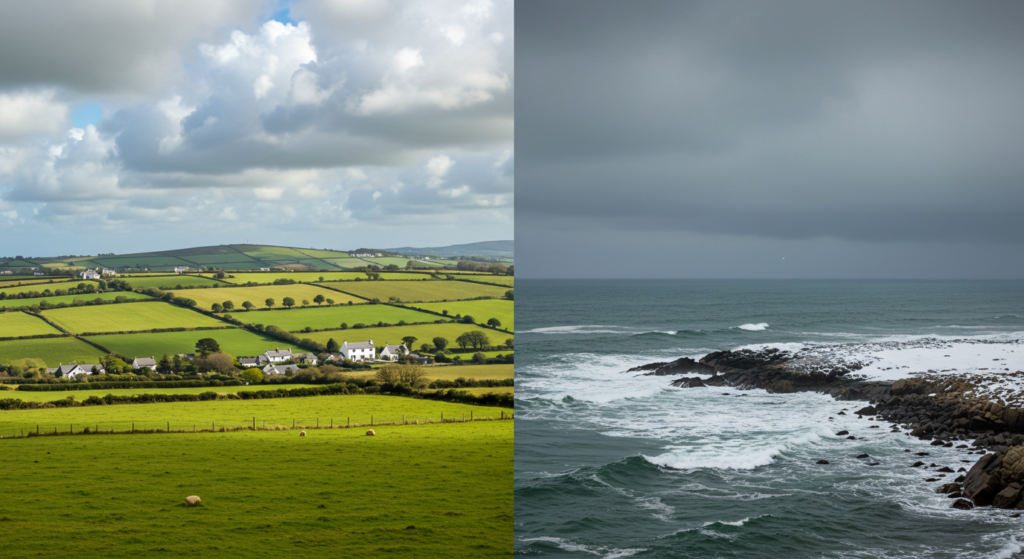
Springtime Emergence
Spring in Ireland can arrive in gentle stages. Grass, already green most of the year, takes on a brighter sheen under longer daylight. Tree buds unfurl, adding light greens to the scenery. Rivers swell with melted rain, sometimes reflecting a softer blue. Heather is usually not blooming yet, so moorlands stay muted. Migratory birds return, filling fields and coastal wetlands. Each sign of new life underscores the land’s resilience.
Travelers who arrive in spring find mild weather and fresh growth. Fields hold young lambs, a sight that warms many hearts. The emerald shade intensifies when beams of sunshine break through clouds. Drizzle is common, but it nourishes the soil. With fewer crowds, it’s easier to walk or drive without distractions. The color palette may be subtler than summer, yet it holds promise of the lush months ahead.
Vibrant Summer Colors
Summer is prime time for Ireland’s color display. The farmland is in full bloom. Crops stretch out, painting the fields in varied shades of green. The Atlantic shines under clearer skies, adopting a bright blue hue on calm afternoons. Coastal towns buzz with events and festivals. Tour boats roam the waters, giving visitors a close look at cliffs and hidden coves. Fishermen may sell fresh catches right off the dock.
Heather starts to bloom in late summer. Purples spread across the moors, adding a vivid accent to the landscape. Warm sun, although sometimes elusive, encourages growth in wildflowers and hedgerows. The countryside can feel abundant, brimming with color. Gardens in heritage homes display bright blossoms. The air may hold scents of cut grass or blooming shrubs. Folks soaking in the sun often remark on how each shade glistens more strongly in summer’s light.
Autumn and Winter Moods
By autumn, green fields may start to brown in patches, especially in drier spots. Leaves on certain trees turn gold or rust, adding warm tones. The ocean can shift to a slate blue under gray skies, with sudden squalls adding drama. Moorland heather has passed its peak bloom, leaving dried stems that still show faint traces of purple. Farmers harvest their last crops, storing feed for livestock as winter nears.
Winter sees short daylight hours. The farmland remains green, but it’s a deeper, subdued shade. Rainfall or frost can add subtle silver flecks to grass. Coastlines might turn wild, with strong waves crashing in a frothy mix of blue and white. Heather stands dormant, waiting for the next cycle. The quiet hush of winter can still charm visitors who seek solitude. The moody weather reveals another side to Ireland’s color story, anchored in earthy tones and raw seascapes.
Cultural Festivals and Color Celebrations
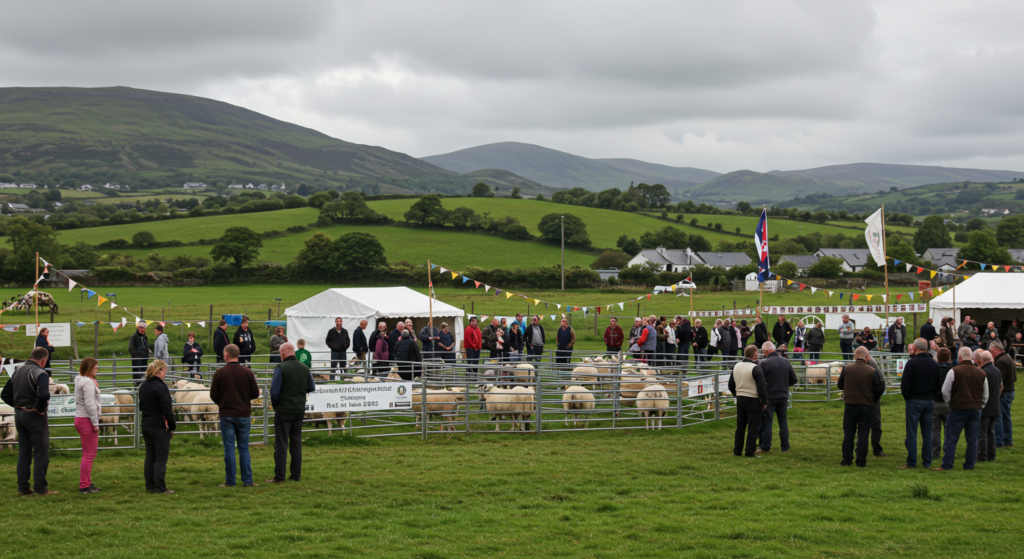
Rural Fairs and Agricultural Shows
Fairs held in small towns often highlight livestock, produce, and crafts. Green is everywhere, from the prize-winning sheep to the well-tended vegetables. Local farmers compete for ribbons. Visitors sample homemade jams or watch sheepdog trials. These events celebrate the land’s bounty in a down-to-earth way. Though color isn’t the main theme, it’s impossible to miss the blanket of green fields and rolling hills around the fairground.
Stalls may feature artisan goods dyed with natural pigments from plants. Musicians might perform folk tunes beneath bright tents, where the green farmland stretches beyond. Children ride ponies or race around with friends, their laughter floating on the breeze. These fairs uphold old traditions, letting communities gather and share news. The emerald tone of the countryside sets the stage for a day of friendly competition and fun.
Coastal Events and Maritime Festivities
Coastal festivals revolve around the sea. Boats line the docks, draped with flags or streamers in bright blues and other colors. Fishermen compete in net-mending contests or hold fishing tournaments. Cooks dish up chowder or grilled fish for hungry visitors. This is a time to pay homage to the Atlantic and its gifts. Old ships might host tours, letting people see how sailors once lived.
Some events include a blessing of the boats, where a local figure gives thanks for safe voyages. It’s a touching moment that ties community life to the ocean’s shifting tones. While the color blue takes center stage, glimpses of green from the shoreline and fields remind everyone of the island’s unity between land and sea. Fireworks might light up the sky, reflecting off dark water at night.
Highland Gatherings and Heather Showcases
In moorland regions, smaller gatherings honor local traditions and natural heritage. Bagpipers or drummers perform in open fields, with purple heather serving as a background. Though these events aren’t as famous as big city festivals, they hold unique charm. Craftspeople sell handmade goods or heather honey, and visitors might see a demonstration of weaving with wild plant fibers.
Sometimes, local storytellers share Gaelic tales of moors, fairies, and hidden treasure. They sit on wooden stools or simple benches, with the purple hills behind them. Attendees watch dancers in traditional garb or join in lively group dancing themselves. The focus is on community, heritage, and the land’s quiet beauty. The purple bloom ties everything together, reminding folks of a simpler way of life that endures.
Irish Crafts, Textiles, and Color Representation
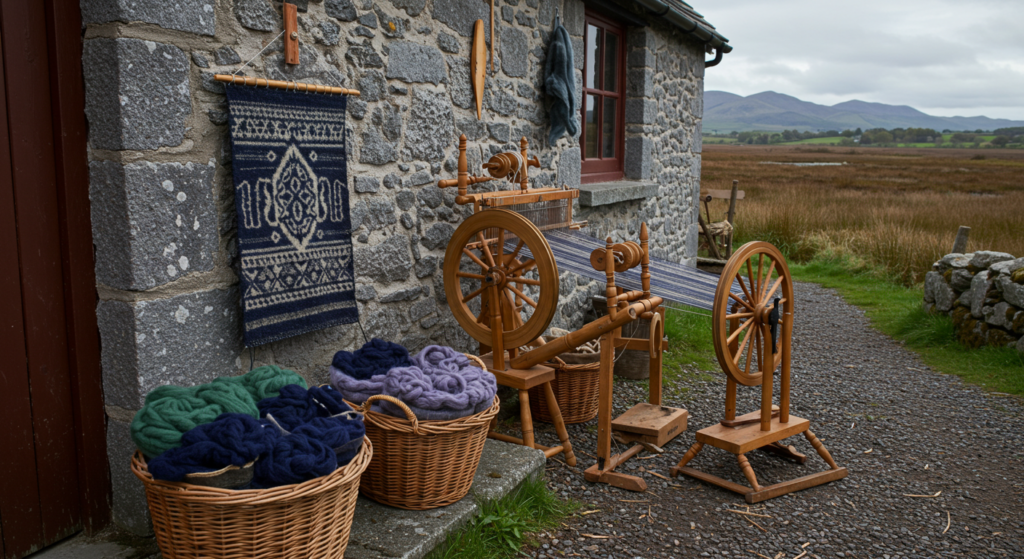
Wool and Natural Dyes
Irish sheep produce high-quality wool. Spinners often source it locally, then use time-honored techniques to dye it. Natural dyes come from plants, lichens, or even crushed shells. Ireland’s green might come from plants like nettle or meadow leaves. Blue is trickier. In older times, woad or imported indigo gave a deep hue. Purple could emerge from blending red and blue sources, though that was rarer.
This process aligns the final textile with the land’s core hues. Sweaters or shawls made this way might show patterns reminiscent of Celtic knots or coastal waves. The subtle color variations hint at the hands-on approach. Each item is unique, a link to Ireland’s environment. While synthetic dyes are common now, certain artisans keep old methods alive, cherishing the slow, mindful craft.
Pottery and Glass Art
Clay and glass artisans in Ireland also draw on local color themes. Potters might shape functional pieces, glazing them in earthy greens that mirror farmland. Some experiment with ocean-inspired blues, layering glazes to mimic shifting tides. The result is a swirling pattern that stands out on a mug or decorative plate. Glassblowers, meanwhile, capture subtle gradations in color. They might produce a piece with purple highlights, reminiscent of heather. Light passing through the glass shifts the tone, offering a dynamic experience.
These crafts often appear in studio shops or local markets. Many artisans share the story of their inspiration. One might mention the wave patterns seen on a windy day. Another might recall the moors at sunrise, with purple smudges across the horizon. Buyers appreciate the authenticity, seeing how each piece reflects an aspect of Ireland’s natural palette.
Jewelry and Gemstones
Though Ireland isn’t famous for large gem deposits, some jewelers use Connemara marble, found in certain western regions. It shows a swirl of green shades, reminiscent of moss and fields. Craftspeople cut and polish the stone into pendants or earrings. Blue topaz or sapphires might reference the Atlantic. Amethyst can evoke the moorland’s purple.
Settings often feature Celtic knot designs or other Irish motifs. Tourists purchase these items as keepsakes of their trip. Locals might wear them as subtle statements of heritage. The blend of colors and motifs in Irish jewelry underscores how the land’s palette can be adapted for small, elegant objects. These pieces stand apart from mass-produced trinkets, reflecting a genuine connection to place.
Music, Dance, and Visual Celebrations of Color
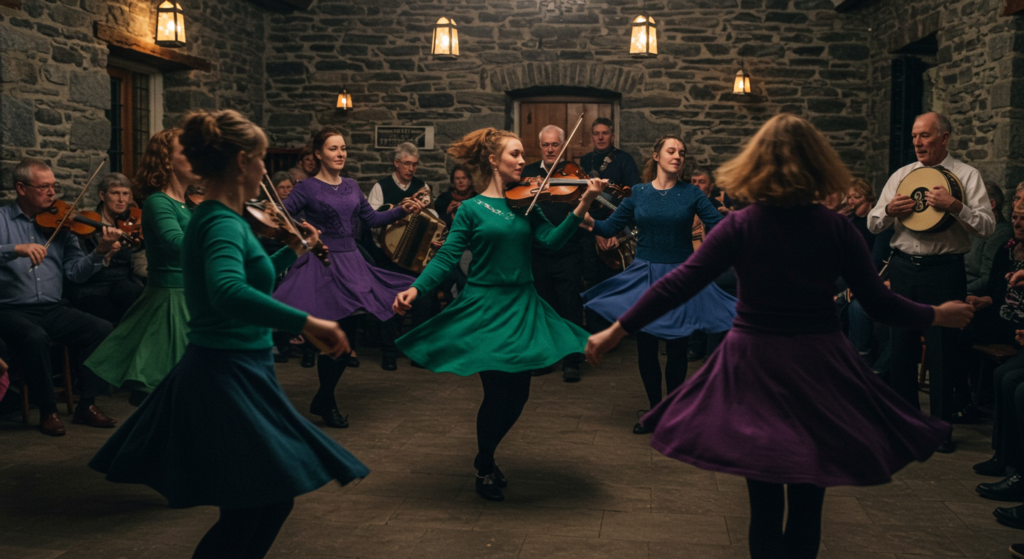
Folk Songs and Color Imagery
Traditional Irish folk songs frequently reference the green hills or the rolling seas. Singers stand in pubs, telling old tales of fishermen or farmers who found solace in nature. Listeners can almost see the greenery and smell the salt air. Tunes about heather might be less common, but some ballads mention lonely moors or purple ridges. The melodies carry the spirit of open fields and restless coasts.
In modern music, references to Ireland’s shades persist. Musicians mix folk instruments with contemporary sounds. Lyrics might feature a longing for the homeland, focusing on a green field or a rugged shoreline. Even in an upbeat song, that longing remains a thread. It’s part of the shared cultural DNA that color has helped define.
Dance Costumes and Stage Performances
Dancers in shows like Riverdance or local ceilidh gatherings often wear outfits in bright greens or blues. Their swift footwork, paired with rhythmic music, evokes rolling hills or leaping waves. The color choice in costumes is no accident. Designers know that these hues tie to Irish tradition and catch the audience’s eye. Performance stages might include backdrops featuring meadows or coastal cliffs.
Some smaller troupes highlight purple in swirling skirts or sashes. It might be a nod to moorland or a creative twist on older norms. When dancers spin under stage lights, the color flares. Spectators see the shimmer, linking movement and hue. It adds a fresh angle to the show, blending old rhythms with new aesthetics.
Modern Art Exhibitions
Galleries in Dublin, Cork, or Belfast often present exhibitions by Irish artists who paint or sculpt with local colors. A painter might focus on farmland scenes, layering greens in thick brushstrokes. Another might capture the Atlantic in a stark, modern style. Purple moors appear as dreamy backdrops or vibrant focal points. Some artists break from realism, using abstract shapes in the signature palette.
These exhibitions challenge viewers to see Ireland anew. They spark discussions about place, memory, and identity. Some pieces sell to collectors worldwide, carrying the essence of Irish color far beyond the island’s shores. The art scene thus grows more diverse, yet remains tethered to a shared foundation: the land’s luminous hues and the stories they hold.
Conclusion
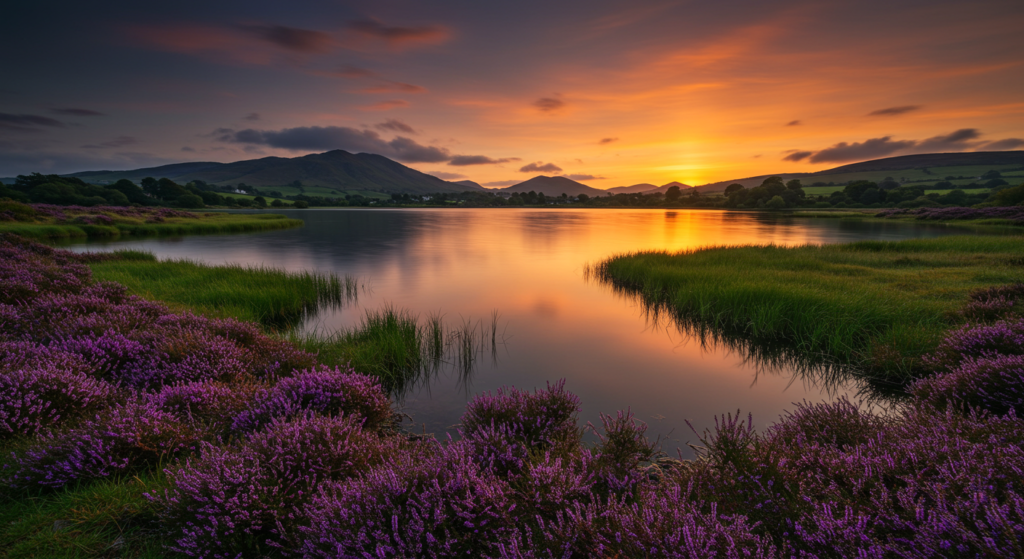
Ireland’s vivid greens, Atlantic blues, and heather purples serve as threads that weave through history, folklore, everyday life, and art. They connect farmland to the coast and moorlands to bustling ports. These shades shaped Ireland’s identity from ancient Gaelic times to the modern era. They also played a role in conflict, trade, religion, and cultural pride.
Explorers of the island see these colors in ruins, large estates, local crafts, or regional foods. Even quick visits can spark a sense of wonder at how the land stays so green, the sea so blue, and the moors so softly purple. These tones aren’t idle backdrops. They’re active participants in Ireland’s story, present in each step across a meadow or every glance at a rugged shore.
Understanding them doesn’t require deep color theory or complex analysis. It calls for a look at how people across centuries have responded to the land’s gifts. One can read a medieval text, taste a fresh catch from Atlantic waters, or wander moorland paths lined with heather. Each experience hints at why color continues to shape Ireland’s essence.
Summary Table
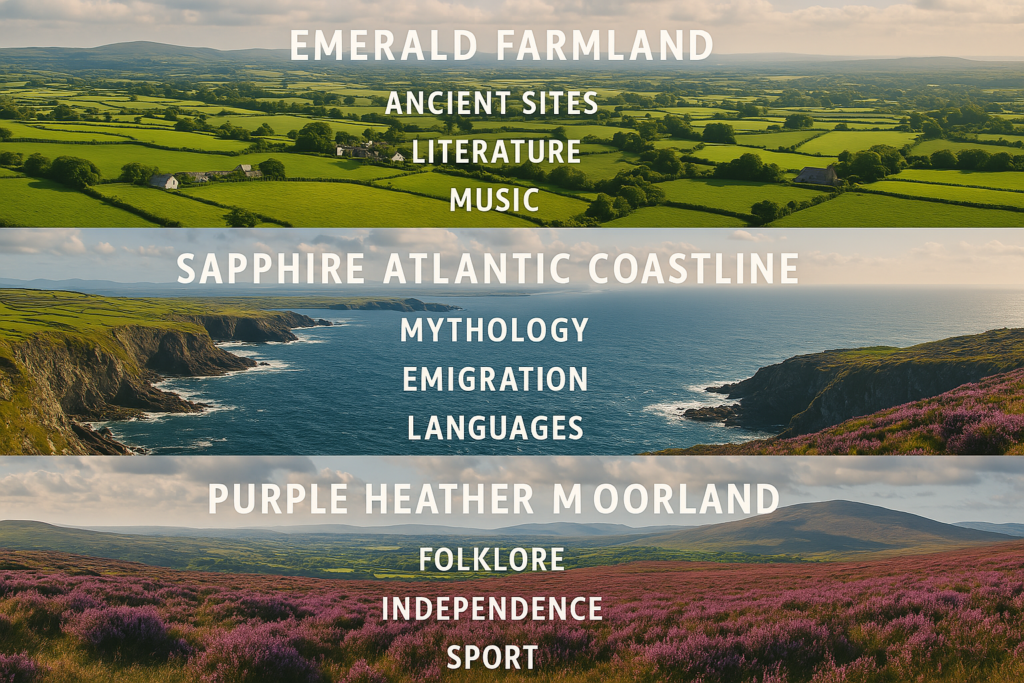
| Aspect | Green (Emerald Fields) | Blue (Atlantic Waters) | Purple (Heather Moors) |
|---|---|---|---|
| Historical Role | Symbol of Gaelic identity, farmland | Key to maritime trade, defense, & culture | Linked to folklore, less documented in texts |
| Location & Setting | Farmlands, valleys, rural pastures | Ports, coastal towns, fishing villages | Highlands, peat bogs, remote upland slopes |
| Cultural Importance | National color, used in flags & symbolism | Pride in seafaring tradition, local fisheries | Quiet sign of tradition, minor spiritual ties |
| Modern Expressions | Apparel, flags, agriculture fairs | Boat festivals, sea-inspired crafts, tourism | Heather honey, textiles, scenic trekking |
| Seasonal Variations | Vibrant all year, peaks in summer | Bright blue in summer, stormy gray in winter | Blooms in late summer, browns in winter |
| Art & Craft Usage | Wool dyes, Celtic motifs, heraldry | Pottery glazes, maritime art, jewelry stones | Wreaths, honey, subtle infusion in crafts |
FAQ
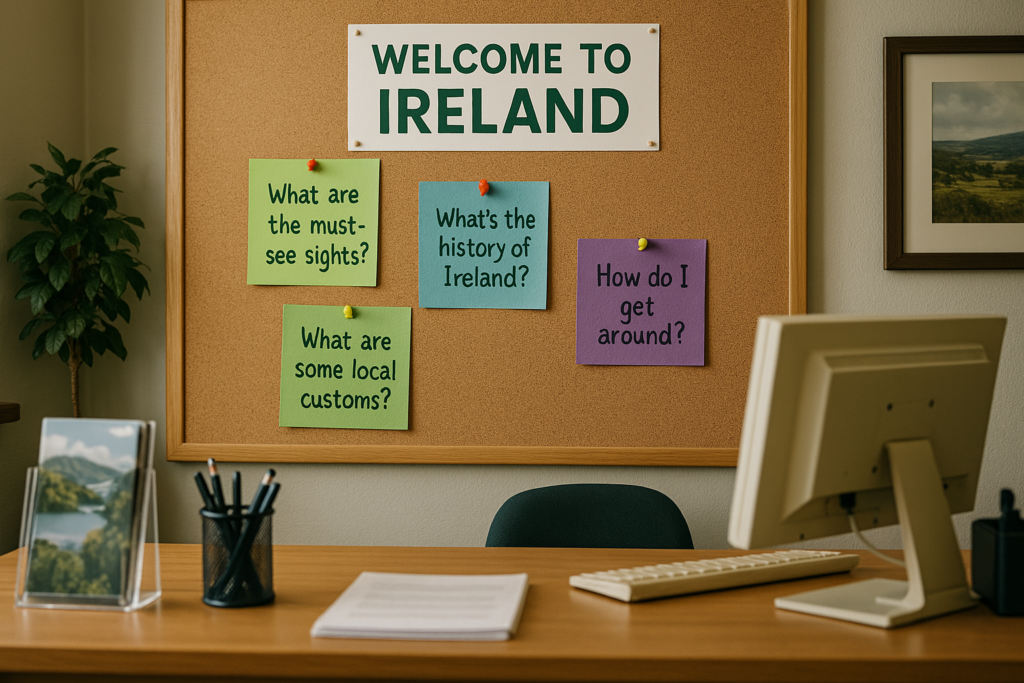
1) Why is Ireland called the “Emerald Isle”?
Because of the country’s lush, rain-fed fields and rolling hills that keep a brilliant green color much of the year. Historical writers and poets praised these fields, helping spread the nickname.
2) Does the Atlantic’s blue color differ across seasons?
Yes. The ocean appears bright blue in calm summer sun and deep navy or even stormy gray during colder, windy months. Light conditions and water turbulence affect how the color looks day to day.
3) Where can someone see purple heather in Ireland?
Many upland regions feature heather in late summer. Spots like the Wicklow Mountains or Connemara showcase broad swathes of this purple bloom. It can also be found on coastal moors and peat bogs.
4) Do these colors influence Irish cuisine?
Green vegetables thrive in Ireland’s mild climate, so they appear in dishes like soups, stews, and colcannon. Seafood from the Atlantic is common along coasts. Heather honey offers a subtle taste linked to moorland blooms.
5) Are there famous places to view the vivid Irish palette?
Yes. The Wild Atlantic Way includes stunning coastal panoramas. Rural counties like Kerry or Clare highlight lush farmland, while the Wicklow Mountains or the Burren region display dramatic heather or rocky landscapes.
6) Is there any historical record of purple as a royal color in Ireland?
Purple was sometimes connected to status due to the cost of certain dyes. But green and blue dominated Ireland’s national and heraldic imagery. Purple mostly appeared in moorland contexts or in limited high-status materials.
7) Does Ireland stay green year-round?
Mostly, yes. Grass remains vibrant thanks to frequent rain and mild winters. Some farmland might turn brown in dry spells, but that’s less common. Winter months still show deep green fields, even under frosty conditions.
8) Are there crafts still using natural dyes for these colors?
Some artisans do. Wool spinners and weavers may use nettles, lichens, or woad. This approach produces softer, more varied tones than commercial dyes. It helps preserve older techniques passed down through generations.
9) How do ancient Gaelic legends tie to Ireland’s colors?
They emphasize the link between land and spirit. Green fields appear in sagas about clan life. Blue seas show up in stories of voyages. Purple moors sometimes figure in tales of solitude or hidden magic.
10) Can visitors join events that highlight these colors?
Yes. Rural fairs celebrate farming (green fields), coastal festivals celebrate fishing or boating (blue sea), and smaller moorland gatherings might highlight wild heather (purple blooms). Each event offers a local perspective on Ireland’s color heritage.

Gabrielle J. Smith is the pulsating essence that brings life to the world of fashion and color. With an innate talent for understanding the nuances of hues, she has the uncanny ability to paint narratives with her words, diving deep into the realm of color trends and the art of harmonizing them. Not just an expert in the field, Gabrielle also plays a pivotal role in strengthening the cohesion of our team, ensuring growth and harmony. Each of her articles is a testament to her passion, weaving captivating tales that resonate with readers and fashion aficionados alike.
Reviewed By: Joanna Perez and Anna West
Edited By: Lenny Terra
Fact Checked By: Matthew Mansour
Photos Taken or Curated By: Matthew Mansour
